Michael J. Behe's Blog, page 514
March 6, 2019
Bill Dembski on censorship of books at Amazon

You think you’re free to read what you want? Think again:
Three days ago on this forum, I raised the question how long would it be before Amazon, which has now started banning videos skeptical of vaccines, starts banning books. I thought books would be safer.
But no. Tommy Robinson’s book Mohammed’s Koran has now been banned on Amazon. For the story, see here. For the Tommy Robinson page at Amazon showing that the book has indeed been removed (proof by absence), see here.
Barnes and Noble has likewise removed it.
… Bill Dembski, “Censorship of Books at Amazon” at billdembski.com
The Big Shuddup was bound to happen in monopoly markets. It is much easier to stop a single leak than hundreds of them.
One naturally hopes it won’t spread to ID or whatever we want to read or watch but who knows? Today, for those in power, the big thing is not to win a debate but stop it from happening.
Follow UD News at Twitter!
Copyright © 2019 Uncommon Descent . This Feed is for personal non-commercial use only. If you are not reading this material in your news aggregator, the site you are looking at is guilty of copyright infringement UNLESS EXPLICIT PERMISSION OTHERWISE HAS BEEN GIVEN. Please contact legal@uncommondescent.com so we can take legal action immediately.
Plugin by Taragana
Deemed “officially weirder”: Octopuses edit their RNA in response to environment
 California two-spot octopus, by Tom Kleindinst via Marine Biological Laboratory.
California two-spot octopus, by Tom Kleindinst via Marine Biological Laboratory. First noted in 2015 but now we read, updated,
This is weird because that’s really not how adaptations usually happen in multicellular animals. When an organism changes in some fundamental way, it typically starts with a genetic mutation – a change to the DNA…
But it looks like cephalopods didn’t get the memo. In 2015, researchers discovered that the common squid has edited more than 60 percent of RNA in its nervous system. Those edits essentially changed its brain physiology, presumably to adapt to various temperature conditions in the ocean.
The team returned in 2017 with an even more startling finding – at least two species of octopus and one cuttlefish do the same thing on a regular basis. To draw evolutionary comparisons, they also looked at a nautilus and a gastropod slug, and found their RNA-editing prowess to be lacking. Signe Dean, “Octopus And Squid Evolution Is Officially Weirder Than We Could Have Ever Imagined” at Science Alert
Some wonder if it has to do with well-developed octopus and squid brains.
Well, first, we don’t really know for sure that no other life form does this. Maybe others do and we haven’t caught up to them yet. It would be easier to place in a context if we had a group to study rather than an outlier.
Epigenetics and horizontal gene transfer are well-known non-Darwinian methods of evolution so it’s hard to see why this should be a big surprise except for those with a total commitment to Darwinism. Increasingly, of course, the Darwinians sound like a cult. Too bad they are still the orthodoxy as well.
Follow UD News at Twitter!
See also: Is the octopus a “second genesis” of intelligence? Also, the apparently non-Darwinian nature of animal intelligence.
Copyright © 2019 Uncommon Descent . This Feed is for personal non-commercial use only. If you are not reading this material in your news aggregator, the site you are looking at is guilty of copyright infringement UNLESS EXPLICIT PERMISSION OTHERWISE HAS BEEN GIVEN. Please contact legal@uncommondescent.com so we can take legal action immediately.
Plugin by Taragana
Fetal development seen as work the work of an intelligent artisan
 structure of an animal cell/royroydeb (CC BY-SA 4.0)
structure of an animal cell/royroydeb (CC BY-SA 4.0)The balance of physical forces that shape developing embryos, moving not quite like liquids or solids but somewhere in between, is compared by a researcher to an artist at work:
Far more than expected, according to results published in Nature earlier this month. For the first time, using a series of clever, state-of-the-art techniques, scientists have uncovered the balance of physical forces that shapes tissues in developing embryos. And the process they’ve identified has turned out to be surprisingly familiar — not for its role in biology, but for its part in revolutionizing how physicists understand a slew of materials ranging from toothpaste to glass…
Campàs and his colleagues measured all three properties in different regions of the developing zebra fish embryo, from head to tail, and showed that the way the cells get packed and change their behavior also fits the theory of jamming. Before, scientists had thought that cells essentially fine-tuned forces, applying more stress here, less there, to guide everything into place like a sculptor molding clay. “Instead,” Campàs said, “it’s more like blowing glass,” like liquefying a part that needs sculpting and then letting its new form set.Jordana Cepelewicz, “‘Traffic Jams’ of Cells Help to Sculpt Embryos” at Quanta
Like blowing glass? Biology’s language is poorly adapted to Darwinism.
Technically, the researcher means “blowing glass but there is no glassblower.” But most people can’t say that and still feel that they are making sense. And maybe they aren’t. But they can certainly make life difficult for any who challenge them.
See also: Fish turn into fluids, which aids embryo development
Cells have a repair crew that fixes local leaks
Researchers: How The Immune System “Thinks”
Follow UD News at Twitter!
Researcher: Mathematics Sheds Light On “Unfathomably Complex” Cellular Thinking
How do cells in the body know where they are supposed to be?
Researchers A Kill Cancer Code Is Embedded in Every Cell
How Do Cells Interpret The “Dizzying” Communications Pathways In Multicellular Life Forms?
and
Cell atlases reveal extreme complexity at biology’s frontiers
Follow UD News at Twitter!
Copyright © 2019 Uncommon Descent . This Feed is for personal non-commercial use only. If you are not reading this material in your news aggregator, the site you are looking at is guilty of copyright infringement UNLESS EXPLICIT PERMISSION OTHERWISE HAS BEEN GIVEN. Please contact legal@uncommondescent.com so we can take legal action immediately.
Plugin by Taragana
New monument to Alfred Russel Wallace

In Sulawesi, Indonesia. Wallace, Darwin’s ignored co-discoverer, had explored a good deal in that area:
A very impressive 1.5 meter tall bust of Wallace on a 2.6 meter high plinth was inaugurated on the 21st February 2019 at the well known Tangkoko Nature Reserve in north-east Sulawesi, Indonesia. It is certainly the largest and most imposing monument to Wallace in the world so far. It is also the first bust or 3D likeness of him outside the UK and the first monument to him in Wallacea, the biogeographical region which is named in his honour. George Beccaloni, “Impressive New Monument to Alfred Russel Wallace in Sulawesi, Indonesia” at The Alfred Russel Wallace Website
Interesting coincidence with finding Wallace’s (thought-extinct) bee. Much else of interest in the linked article.
Follow UD News at Twitter!
See also: Alfred Russel Wallace’s Giant Bee Turns Out Not To Be Extinct
and
Science Journalist Michael Shermer Would Like To Have A Beer With Alfred Russel Wallace. But Would Wallace Decline? Wallace had to be sidelined because he was not a philosophical naturalist (nature is all there is, often called “materialism”) and was never willing to make a religion out of natural selection.
Copyright © 2019 Uncommon Descent . This Feed is for personal non-commercial use only. If you are not reading this material in your news aggregator, the site you are looking at is guilty of copyright infringement UNLESS EXPLICIT PERMISSION OTHERWISE HAS BEEN GIVEN. Please contact legal@uncommondescent.com so we can take legal action immediately.
Plugin by Taragana
Logic and First Principles, 13: The challenge of creeping scientism (and of linked nominalism)
There is a creeping scientism in our intellectual climate.
We have been led to think that Science is the gold standard of reliable, substantial knowledge and that institutional science and its leaders are the curators of knowledge. This is of course deeply connected to the wider domination of evolutionary materialistic scientism, which compounds the above with the notion that the stuff studied by the physical and chemical sciences is effectively the limit of credibly, reliably knowable reality.
Where, let us note that scientism is a part of the defining cluster of naturalism, in both its metaphysical and “methodological” guises. We can readily see that in that ever so humble source, Wikipedia, speaking confidently and comfortably on its own philosophical bent:
“Naturalism can intuitively be separated into an ontological and a methodological component,” argues David Papineau.[3] “Ontological” refers to the philosophical study of the nature of being. Some philosophers equate naturalism with materialism. For example, philosopher Paul Kurtz argues that nature is best accounted for by reference to material principles. These principles include mass, energy, and other physical and chemical properties accepted by the scientific community. Further, this sense of naturalism holds that spirits, deities, and ghosts are not real and that there is no “purpose” in nature. Such an absolute belief in naturalism is commonly referred to as metaphysical naturalism.[4]
Assuming naturalism in working methods as the current paradigm, without the further consideration of naturalism as an absolute truth with philosophical entailment [–> as in, let’s keep it implicit], is called methodological naturalism.[5] The subject matter here is a philosophy of acquiring knowledge based on an assumed paradigm.
Notice, the latter point, suitably highlighted: “[T] he subject matter here is a philosophy of acquiring knowledge based on an assumed paradigm.”
Telling.
But, in fact, all of this is ill-informed.
Science, insofar as it creates large scale explanatory constructs, is inherently unable to rise to the first level of responsible certainty, moral certainty. That is, theories and models are inherently highly provisional and are subject to correction or replacement based on logical critique or empirical observations. That’s why we talk about paradigm shifts and scientific revolutions. Today’s dominant school of thought can become tomorrow’s dead theory, often one funeral at a time.
Scientific observations of course can indeed be morally certain, but that is if they are the testimony of reliable witnesses, not because they are scientific. This is part of why observations test and can overthrow theories. Models don’t even aspire to the possibility of truth, they only hope to give good enough results in some domain of practice or other.
So, too, we can see that the tendency to view for instance Mathematics as a Science in the modern sense, is ill-founded. Core mathematical facts and necessary realities are necessary truths or entities, they are far more strongly warranted than scientific frameworks or even observations.
Similarly, nominalism (especially as regards mathematics) is questionable. It is of course the default view of most mathematical practitioners that the substance of their practice is embedded in reality, is somehow real although abstract so that core mathematical entities and their properties are discovered rather than invented, notably if one makes a paper mobius strip and cuts it around in the centre vs 1/3 way across, one gets a dramatically different result. And again, those contrast with cutting around an ordinary cylindrical loop of paper. There are many, many other cases.
This has been challenged by nominalists, who tend to dismiss the reality of abstracta, or to hold that abstraction is “merely” a concept we form to collect phenomena we perceive as somehow related, in effect a form of words. Some would hold that the reality of mathematical entities is that we hold them in our minds (whatever such minds are and however they arise). In this context, axiomatisations then effectively determine mathematical truth as what comes from successful axioms, as we play the collective intellectual game we term Mathematics. Thus the study of the logic of structure and quantity is the focus, the notion that there is a substantial body of discoverable substance independent of our culturally influenced thought and invention is deprecated or even dismissed. As the Standford Encyclopedia of Philosophy outlines:
Nominalism about mathematics (or mathematical nominalism) is the view according to which either mathematical objects, relations, and structures do not exist at all, or they do not exist as abstract objects (they are neither located in space-time nor do they have causal powers). In the latter case, some suitable concrete replacement for mathematical objects is provided. Broadly speaking, there are two forms of mathematical nominalism: those views that require the reformulation of mathematical (or scientific) theories in order to avoid the commitment to mathematical objects (e.g., Field 1980; Hellman 1989), and those views that do not reformulate mathematical or scientific theories and offer instead an account of how no commitment to mathematical objects is involved when these theories are used (e.g., Azzouni 2004) . . . .
In ontological discussions about mathematics, two views are prominent. According to platonism, mathematical objects (as well as mathematical relations and structures) exist and are abstract; that is, they are not located in space and time and have no causal connection with us. Although this characterization of abstract objects is purely negative—indicating what such objects are not—in the context of mathematics it captures the crucial features the objects in questions are supposed to have. According to nominalism, mathematical objects (including, henceforth, mathematical relations and structures) do not exist, or at least they need not be taken to exist for us to make sense of mathematics. So, it is the nominalist’s burden to show how to interpret mathematics without the commitment to the existence of mathematical objects.
Such nominalism, however, is problematic. In a sense, such is unsurprising, all philosophically tinged schools of thought bristle with difficulties so that a key method of philosophy is comparative difficulties. However, it is arguable that in mathematics, nominalism goes a bridge too far. We can readily see that the results of making and cutting paper loops in particular ways are independent of our views, understanding, axiom systems and the like. In fact, if an axiom system would contradict the facts of structure and quantity we see on the ground, it would be severely challenged as unrealistic and likely irrelevant. More could be said, but enough is on the table that we can see why so many practitioners are firmly convinced that there is a discoverable substance of structure and quantity that is there, albeit not concrete. There is no mental or technological tool or instrument that would allow us to spy out a realm where we find a repository holding for example THE null set.
And we already see by the above, that the domain that studies degree of warrant, reliability and certainty of knowledge claims is not science, but philosophy. This is part of the task of Epistemology, one of its branches.
So, first, we must recognise the limitations of science and that the ideology of evolutionary materialistic scientism is self referentially incoherent (as Rosenberg so aptly but inadvertently demonstrates) and necessarily false. The self-refuting is logically falsified. It is worth quoting Rosenberg in his own voice, as a reminder:
Alex Rosenberg as he begins Ch 9 of his The Atheist’s Guide to Reality:
>> FOR SOLID EVOLUTIONARY REASONS, WE’VE BEEN tricked into looking at life from the inside. Without scientism, we look at life from the inside, from the first-person POV (OMG, you don’t know what a POV is?—a “point of view”). The first person is the subject, the audience, the viewer of subjective experience, the self in the mind. Scientism shows that the first-person POV is an illusion. [–> grand delusion is let loose in utter self referential incoherence] Even after scientism convinces us, we’ll continue to stick with the first person. But at least we’ll know that it’s another illusion of introspection and we’ll stop taking it seriously. We’ll give up all the answers to the persistent questions about free will, the self, the soul, and the meaning of life that the illusion generates [–> bye bye to responsible, rational freedom on these presuppositions]. The physical facts fix all the facts. [–> asserts materialism, leading to . . . ] The mind is the brain. It has to be physical and it can’t be anything else, since thinking, feeling, and perceiving are physical process—in particular, input/output processes—going on in the brain. We [–> at this point, what “we,” apart from “we delusions”?] can be sure of a great deal about how the brain works because the physical facts fix all the facts about the brain. The fact that the mind is the brain guarantees that there is no free will. It rules out any purposes or designs organizing our actions or our lives [–> thus rational thought and responsible freedom]. It excludes the very possibility of enduring persons, selves, or souls that exist after death or for that matter while we live.>>
Next, we must recognise that without people, there is no science. People, able to think rationally, responsibly and with significant freedom, a freedom that is morally governed by duty to truth, right reason, prudence, fairness etc. That is, we see here that it is inescapably true that we have minds of our own, minds that are utterly transcendent relative to what blindly mechanical and/or stochastic GIGO-limited, computing on a computational substrate, its organisation and software can do. Computers are refined, organised rocks and they have no dreams; rational, reflective, active, contemplative thought is beyond such. Even a profoundly deluded mind rises above mechanistic and/or stochastic computation, through self-awareness:
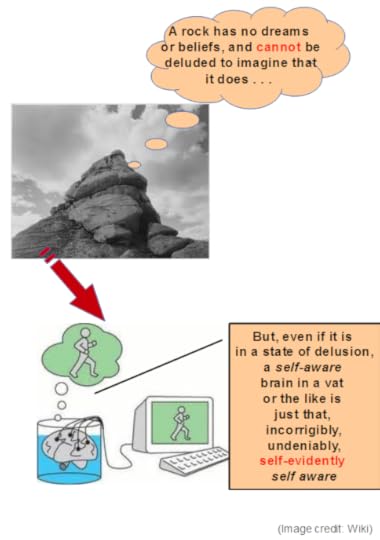
Thus, as reasoning we have reason to take seriously the view that the brain is an interface, not the de-limiting computational substrate. The Smith, two-tier controller cybernetic bio-bot model can help us catch a glimpse of how that might be:
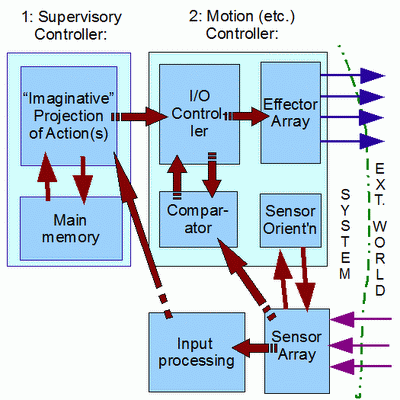 The Derek Smith two-tier controller cybernetic model
The Derek Smith two-tier controller cybernetic modelWe therefore look at other philosophical issues, recognising that just to reason, we face the inescapable truth that we must have minds of our own, minds that have properties drastically different from those of dynamic-stochastic systems including computational substrates. Reppert, aptly summarised:
[L]et us suppose that brain state A [–> notice, state of a wetware, electrochemically operated computational substrate], which is token identical to the thought that all men are mortal, and brain state B, which is token identical to the thought that Socrates is a man, together cause the belief [–> concious, perceptual state or disposition] that Socrates is mortal. It isn’t enough for rational inference that these events be those beliefs, it is also necessary that the causal transaction be in virtue of the content of those thoughts . . . [But] if naturalism is true, then the propositional content is irrelevant to the causal transaction that produces the conclusion, and [so] we do not have a case of rational inference. In rational inference, as Lewis puts it, one thought causes another thought not by being, but by being seen to be, the ground for it. But causal transactions in the brain occur in virtue of the brain’s being in a particular type of state that is relevant to physical causal transactions.
Recall, our ability to be responsibly, freely rational is antecedent to science and is a condition we must implicitly accept just to credibly do scientific and linked mathematical reasoning. Therefore, it is not explanatorily empty to accept on reasoned reflection that we have reason to accept that mind reflects an order of reality that transcends the picture painted by scientism or by evolutionary materialism.
So, we now look at questions from another branch of core philosophy,
the logic of being, i.e. ontology, a sub-discipline of metaphysics which
studies being. What sort of thing must mind be to have the properties
that are inescapable if we are to have a consensus-building community of
rational, credible discussion?
We find that conscious, self-aware, reflective, volitional, conscience guided, more or less intelligent, rationally and morally governed mind is our first fact; the fact through which we process others. So, such things are inescapably certain, in many ways.
Where also, one of the empirical observations we make, is that design exists and often has in it highly reliable signs of intelligent, purposeful design that we may observe. Where also as contingent creatures, we cannot delimit possible intelligences. So, we know that where we see reliable signs of design, we are warranted to infer that as best explanation, indeed, as a scientific inference, that intelligently directed configuration — design — is a material causal factor. In the world of life, this immediately comes out when we notice the genetic code and its role in protein synthesis.
Code:
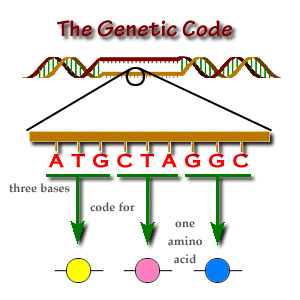 The Genetic Code in action
The Genetic Code in actionSynthesis:
 Protein Synthesis (HT: Wiki Media)
Protein Synthesis (HT: Wiki Media)Going further, the observed cosmos and its physics are pervaded with fine tuning, a strong sign of design. Where also atomic matter and the mathematics of cosmology point to contingency of being. As Luke Barnes summarises:
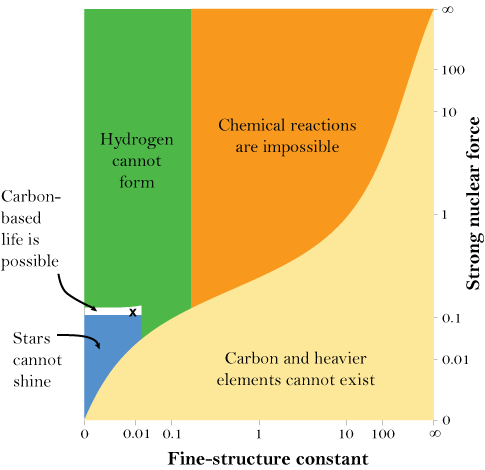 Barnes: “What if we tweaked just two of the fundamental constants? This figure shows what the universe would look like if the strength of the strong nuclear force (which holds atoms together) and the value of the fine-structure constant (which represents the strength of the electromagnetic force between elementary particles) were higher or lower than they are in this universe. The small, white sliver represents where life can use all the complexity of chemistry and the energy of stars. Within that region, the small “x” marks the spot where those constants are set in our own universe.” (HT: New Atlantis)
Barnes: “What if we tweaked just two of the fundamental constants? This figure shows what the universe would look like if the strength of the strong nuclear force (which holds atoms together) and the value of the fine-structure constant (which represents the strength of the electromagnetic force between elementary particles) were higher or lower than they are in this universe. The small, white sliver represents where life can use all the complexity of chemistry and the energy of stars. Within that region, the small “x” marks the spot where those constants are set in our own universe.” (HT: New Atlantis)We need a deeper root of reality than the physical world we inhabit. One that can accommodate designers.
This is pointing to mind as antecedent to matter.
Also, as we are minded, embodied, contingent, morally governed creatures, we see that the roots of reality reflect properties of mindedness (intelligence, purpose, creative synthesis are components of designing) AND moral properties. This points to mind that is of moral character sufficient to ground our moral government. All of this is reasoned thought, not empty, woolly speculation on culturally available myths.
Evolutionary materialistic scientism (aka Naturalism) and its fellow travellers, simply cannot sufficiently address what we face in confronting and trying to understand reality. We need a fresh start as a civilisation. END
Copyright © 2019 Uncommon Descent . This Feed is for personal non-commercial use only. If you are not reading this material in your news aggregator, the site you are looking at is guilty of copyright infringement UNLESS EXPLICIT PERMISSION OTHERWISE HAS BEEN GIVEN. Please contact legal@uncommondescent.com so we can take legal action immediately.
Plugin by Taragana
Astronomer: We’re too dumb to think space object Oumuamua was extraterrestrial lightsail
 Artist’s impression of interstellar asteroid/comet, Oumuamua /ESO, M. Kornmesser
Artist’s impression of interstellar asteroid/comet, Oumuamua /ESO, M. Kornmesser The astronomer who identified space object Oumuamua as an extgraterrrestrial light sail tells us, “ Given our sloppy behavior in transmitting signals to outer space without restraint, we can only hope that we have not become the laughingstock of our galactic neighbourhood by now:
If other civilizations do exist, one key in becoming aware of them is whether we are intelligent enough to adequately interpret their signals or to identify a piece of their technology if it should appear in our solar system. One fact is clear: if we assign a zero prior probability for such evidence coming our way, as some scientists did in the case of ‘Oumuamua by invoking the principle “it’s never aliens,” we will indeed never find any. We will be like ostriches burying our heads in the sand.
In fact, this attitude may be one sign that our intelligence isn’t very impressive—that the human race as a whole suffers from the Dunning-Kruger effect, in which those with mediocre abilities insist that they’re unusually talented or smart …
As natural as this suggestion to search might seem, however it is evident that SETI faces a hostile mainstream culture in astronomy. The simple proposal to consider the possibility that ‘Oumumua is technological debris as an explanation for its unusual properties, for example was met with controversy on social media.Abraham Loeb, “Are We Really the Smartest Kid on the Cosmic Block?” at Scientific American
Hmmm. In the real world, when you are an only child so far as you know, it is hard to compare yourself to your siblings. Few readily accept criticism for failure to measure up to the standards of imaginary beings.
Note: The “Dunning-Kruger effect”? For more, from a somewhat different perspective, see Michael Egnor’a “Scientism is not a cure for stupidity—But never mind, quite a few science savants have rushed in fearlessly” It turns out that there is academic research on stupidity (but probably only special savants understand it).
Follow UD News at Twitter!
See also: Astronomers: Solar System Object In Transit, Oumuamua, Might Be A “Light Sail Of Extra-Terrestrial Origin”
Why Some Scientists Saw Asteroid Oumuamua As ET
Why can top scientists get away with extraordinary claims?
and
“Tales of an Invented God. Why They must be Out There.
Follow UD News at Twitter!
Copyright © 2019 Uncommon Descent . This Feed is for personal non-commercial use only. If you are not reading this material in your news aggregator, the site you are looking at is guilty of copyright infringement UNLESS EXPLICIT PERMISSION OTHERWISE HAS BEEN GIVEN. Please contact legal@uncommondescent.com so we can take legal action immediately.
Plugin by Taragana
March 5, 2019
Researchers: Habitable zone is probably narrower than hoped
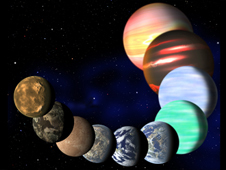 types of planets Kepler found/NAA
types of planets Kepler found/NAA Various researchers have claimed that there could be 40 billion to 100 billion habitable planets in the Milky Way but recent research throws cold water on that:
These results are certainly encouraging, since they suggest that the Milky Way could be teeming with life. Unfortunately, more recent research into extra-solar planets has cast doubt on these previous estimates. This is especially the case where tidally-locked planets that orbit M-type (red dwarf) stars are concerned.
In addition, research into how life evolved on Earth has shown that water alone does not guarantee life – nor, for that matter, does the presence of oxygen gas. Further to this, Schwieterman and his colleagues considered two other major biosignatures that are essential to life as we know it – carbon dioxide and carbon monoxide. Matt Williams, “Complex Life Might Require a Very Narrow Habitable Zone” at Universe Today
He goes on to raise many additional issues as well.
Follow UD News at Twitter!
See also: Astrophysicist: Alien Hunters, Please Stop Using The Drake Equation
Copyright © 2019 Uncommon Descent . This Feed is for personal non-commercial use only. If you are not reading this material in your news aggregator, the site you are looking at is guilty of copyright infringement UNLESS EXPLICIT PERMISSION OTHERWISE HAS BEEN GIVEN. Please contact legal@uncommondescent.com so we can take legal action immediately.
Plugin by Taragana
Were early planetesimals Earth’s source of water and biogenic elements?
Planetesimals are small, accreting bodies in orbit that, massing together, eventually form moons or planets. Origin of life researcher David Deamer (University of California-Santa Cruz) suggests places like Yellowstone National Park rather than salty oceans as life’s first incubators.
And he lays out 18 physical, chemical and emergent processes that must take place for life to begin, claiming that so far “None of the published simulations [including those of Miller, Szostak, Orgel, Joyce, Sydney Fox, Noireaux & Libchaber (partial list)] is sufficiently complex!”.Suzan Mazur, “Origin of Life Fever & Dave Deamer’s Tips on Assembling Life” at Oscillations
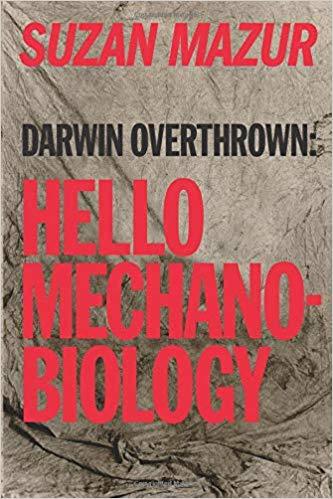
We keep discovering new processes too, so there are certainly enough research areas to go around.
Suzan Mazur is the author of Darwin Overthrown: Hello Mechanobiology
Note: I’ve had a chance to read Mazur’s interview with French scientist Vincent Fleury on the origin of form (with, as it happens, background noise supplied by PZ Myers). Fleury’s approach, which attempts to see the underlying patterns, is instructive and I am looking forward to reading more of the interviews in the book soon. – O’Leary for News
Follow UD News at Twitter!
See also: Suzan Mazur Asks: How Far Have We Gotten In Understanding The Mechanome?
Planetesimals:
Copyright © 2019 Uncommon Descent . This Feed is for personal non-commercial use only. If you are not reading this material in your news aggregator, the site you are looking at is guilty of copyright infringement UNLESS EXPLICIT PERMISSION OTHERWISE HAS BEEN GIVEN. Please contact legal@uncommondescent.com so we can take legal action immediately.
Plugin by Taragana
Cells and proteins use sugars to talk to one another
 structure of an animal cell/royroydeb (CC BY-SA 4.0)
structure of an animal cell/royroydeb (CC BY-SA 4.0)From ScienceDaily:
Research reveals how cells communicate at the molecular level. They found that sugar molecules play a key role in cellular communication, serving as the ‘channels’ that cells and proteins use to talk to one another. This work also provides researchers with a new tool to study other living systems in incredible detail, enabling future breakthroughs in fields from materials science to nanomedicine. Paper.(open access) – Cesar Rodriguez-Emmenegger, Qi Xiao, Nina Yu. Kostina, Samuel E. Sherman, Khosrow Rahimi, Benjamin E. Partridge, Shangda Li, Dipankar Sahoo, Aracelee M. Reveron Perez, Irene Buzzacchera, Hong Han, Meir Kerzner, Ishita Malhotra, Martin Möller, Christopher J. Wilson, Matthew C. Good, Mark Goulian, Tobias Baumgart, Michael L. Klein, Virgil Percec. Encoding biological recognition in a bicomponent cell-membrane mimic. Proceedings of the National Academy of Sciences, 2019; 201821924 DOI: 10.1073/pnas.1821924116 More.
Cells are like Neanderthal man. They get smarter every time we run into them. And just think, it all just tumbled into existence by natural selection acting on random mutations (Darwinism) too…
Before you go: Researchers: First animal cell was not simple; it could “transdifferentiate” From the paper: “… these analyses offer no support for the homology of sponge choanocytes and choanoflagellates, nor for the view that the first multicellular animals were simple balls of cells with limited capacity to differentiate.”
“Interspecies communication” strategy between gut bacteria and mammalian hosts’ genes described
Researchers: Cells Have A Repair Crew That Fixes Local Leaks
Researchers: How The Immune System “Thinks”
Follow UD News at Twitter!
Researcher: Mathematics Sheds Light On “Unfathomably Complex” Cellular Thinking
How do cells in the body know where they are supposed to be?
Researchers A Kill Cancer Code Is Embedded in Every Cell
How Do Cells Interpret The “Dizzying” Communications Pathways In Multicellular Life Forms?
and
Cell atlases reveal extreme complexity at biology’s frontiers
Copyright © 2019 Uncommon Descent . This Feed is for personal non-commercial use only. If you are not reading this material in your news aggregator, the site you are looking at is guilty of copyright infringement UNLESS EXPLICIT PERMISSION OTHERWISE HAS BEEN GIVEN. Please contact legal@uncommondescent.com so we can take legal action immediately.
Plugin by Taragana
March 4, 2019
The academic study of stupidity has turned up some interesting findings

As Michael Egnor tells us, scientism is not a cure for stupidity. But never mind, quite a few science savants have rushed in fearlessly:
Evolutionary biologist David Krakauer, President of the Santa Fe Institute, told Nautilus, “Stupidity is using a rule where adding more data doesn’t improve your chances of getting [a problem] right. In fact, it makes it more likely you’ll get it wrong.”
I won’t contradict an evolutionary biologist on the topic of stupidity. In any event, Italian economic historian Carlo M. Cipolla (1922–2000) argued that “A stupid person is a person who causes losses to another person or to a group of persons while himself deriving no gain and even possibly incurring losses” (his Third Basic Law of Stupidity).
Harming another, with no benefit to oneself, would be stupid. Where would we be without professors of economic history? It turns out that there is academic research on stupidity, including one team of researchers that sought a common definition based on having a group rate apparently stupid actions …
One cure for stupidity is said to be a scientific way of thinking, with Carl Sagan (1934–1996), a noted opponent of intelligent design, offered as a prime example. Dr. Egnor notes,
Sagan was so sure of this that, an opponent of intelligent design, he wrote Contact, a fine novel obliviously extolling… intelligent design. Possibly a classic in “Confident ignorance” rooting out prudence “like a garden weed.” More.
Follow UD News at Twitter!

Michael Egnor is a neurosurgeon, professor of Neurological Surgery and Pediatrics and Director of Pediatric Neurosurgery, Neurological Surgery, Stonybrook School of Medicine
Also by Michael Egnor: > The Real Reason Why Only Human Beings Speak Language is a tool for abstract thinking—a necessary tool for abstraction—and humans are the only animals who think abstractly.
and
How is human language different from animal signals?
Copyright © 2019 Uncommon Descent . This Feed is for personal non-commercial use only. If you are not reading this material in your news aggregator, the site you are looking at is guilty of copyright infringement UNLESS EXPLICIT PERMISSION OTHERWISE HAS BEEN GIVEN. Please contact legal@uncommondescent.com so we can take legal action immediately.
Plugin by Taragana
Michael J. Behe's Blog
- Michael J. Behe's profile
- 219 followers



